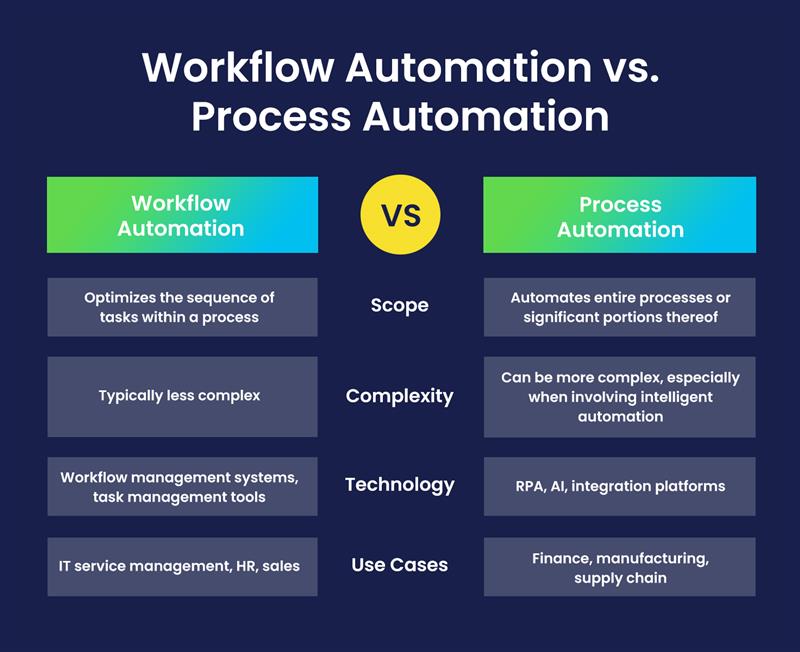Workflow Automation and Process Automation are two terms often used interchangeably in the realm of business efficiency. While they share the goal of streamlining operations, they have distinct approaches and applications.
Workflow Automation focuses on optimizing the sequence of tasks within a process. It involves automating the handoffs and approvals between different steps, ensuring a smooth flow of work. Think of it as automating the “roadmap” of a process.
On the other hand, Process Automation goes beyond task-level automation. It involves automating entire processes or significant portions thereof, often using technologies like robotic process automation (RPA). This means automating repetitive, rule-based tasks that were previously performed manually.
The key difference lies in their scope. Workflow automation is about improving the flow of work, while process automation is about automating the work itself.
Now, let’s get into each in detail.
Definition: Workflow automation involves automating the sequence of tasks within a process. It typically focuses on streamlining handoffs, approvals, and notifications between different steps.
Example: In an IT service management process, workflow automation can automatically assign incident tickets to the appropriate support team based on the nature of the issue. It can also send notifications to the requester and support team when the incident is resolved.
Definition: Process automation involves automating entire processes or significant portions thereof, often using technologies like robotic process automation (RPA). It focuses on automating repetitive, rule-based tasks that were previously performed manually.
Example: In a finance department, process automation can be used to automatically extract data from invoices, populate accounting systems, and reconcile accounts. This can significantly reduce manual effort and improve the accuracy of financial records.

Workflow automation focuses on optimizing the sequence of tasks within a process. This involves streamlining handoffs, approvals, and notifications between different steps. It’s often used in processes involving multiple steps, approvals, and handoffs, such as IT service management, human resources, and sales.Process automation goes beyond task-level automation. It involves automating entire processes or significant portions thereof, often using technologies like robotic process automation (RPA). This approach is ideal for automating repetitive, rule-based tasks in areas like finance, manufacturing, and supply chain.
Complexity varies between the two. Workflow automation typically involves less complexity, as it primarily focuses on defining the sequence of tasks and assigning responsibilities. Process automation, especially when involving intelligent automation technologies like machine learning and natural language processing, can be more complex.
Technology plays a crucial role in both approaches. Workflow automation primarily relies on workflow management systems, task management tools, and communication platforms. Process automation leverages robotic process automation (RPA), artificial intelligence (AI), and integration platforms to automate tasks and processes.
Choosing between workflow and process automation depends on your specific needs. If your primary goal is to improve the efficiency and visibility of existing processes, workflow automation is a good choice. For automating significant portions of your processes, especially repetitive, rule-based tasks, process automation is more suitable.
In many cases, a combination of workflow and process automation can be effective. Workflow automation can help streamline the overall process, while process automation can automate specific tasks within that process. For example, a company might use workflow automation to manage the approval process for purchase orders, while using process automation to automatically extract data from invoices and populate accounting systems.
Following these best practices and addressing potential challenges, will help you successfully implement workflow and process automation to drive efficiency, improve productivity, and achieve your business goals.
In summary, workflow automation and process automation are two powerful tools for improving business efficiency and productivity. While they share the goal of streamlining operations, they have distinct approaches and applications.
Workflow automation focuses on optimizing the sequence of tasks within a process, while process automation involves automating entire processes or significant portions. Both approaches can deliver significant benefits, including increased efficiency, reduced errors, cost savings, and improved customer satisfaction.
Charter Global‘s expertise in automation solutions can help organizations effectively leverage these technologies to drive innovation and achieve their business objectives. With our deep understanding of workflow and process automation, we can provide tailored solutions that meet your specific needs and deliver measurable results.
Partner with Charter Global to explore the possibilities of automation in your organization.
Contact us for a Consultation.
Or email us at [email protected] or call +1 770.326.9933.